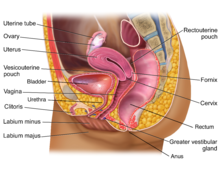Reproductive biology
[4] The female reproductive system includes the structures involved in ovulation, fertilization, development of an embryo, and birth.
[1] However, in sexual reproduction new organisms are formed by the fusion of haploid sperm and eggs resulting in what is known as the zygote.
Such information may be critical to preventing widespread extinction as species are increasingly affected by climate change and other threats.
In mature testes primordial germ cells divide mitotically to form the spermatogonia, which in turn generate spermatocytes by mitosis.
[10] Starting at puberty the process of meiosis can complete resulting in the secondary oocyte and the first polar body.
[11] Outcrossing provides the benefit of genetic complementation, that is, the masking of expression of deleterious recessive alleles in progeny (see heterosis, hybrid vigor).
[11] Genetic variation among progeny produced as a byproduct of sexual reproduction may also have adaptive consequences by providing infrequent beneficial variants that contribute to long-term evolutionary success.
